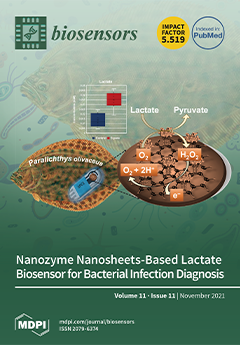Considering the vital physiological functions of dopamine (DA) and uric acid (UA) and their coexistence in the biological matrix, the development of biosensing techniques for their simultaneous and sensitive detection is highly desirable for diagnostic and analytical applications. Therefore, Ti
3C
2
[...] Read more.
Considering the vital physiological functions of dopamine (DA) and uric acid (UA) and their coexistence in the biological matrix, the development of biosensing techniques for their simultaneous and sensitive detection is highly desirable for diagnostic and analytical applications. Therefore, Ti
3C
2T
x/rGO heterostructure with a double-deck layer was fabricated through electrochemical reduction. The rGO was modified on a porous Ti
3C
2T
x electrode as the biosensor for the detection of DA and UA simultaneously. Debye length was regulated by the alteration of rGO mass on the surface of the Ti
3C
2T
x electrode. Debye length decreased with respect to the rGO electrode modified with further rGO mass, indicating that fewer DA molecules were capable of surpassing the equilibrium double layer and reaching the surface of rGO to achieve the voltammetric response of DA. Thus, the proposed Ti
3C
2T
x/rGO sensor presented an excellent performance in detecting DA and UA with a wide linear range of 0.1–100
M and 1–1000
M and a low detection limit of 9.5 nM and 0.3
M, respectively. Additionally, the proposed Ti
3C
2T
x/rGO electrode displayed good repeatability, selectivity, and proved to be available for real sample analysis.
Full article






